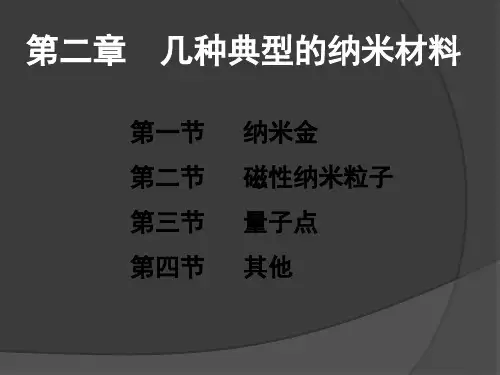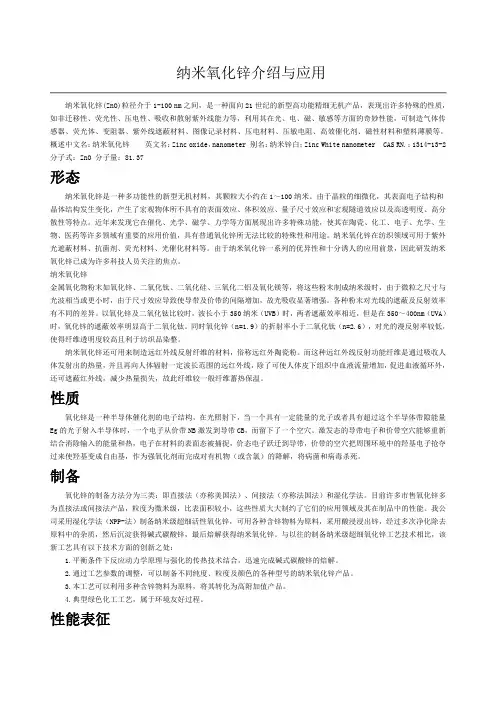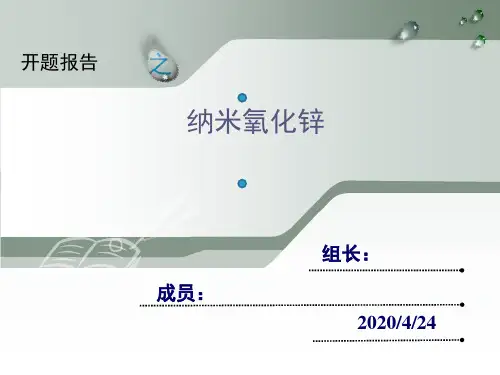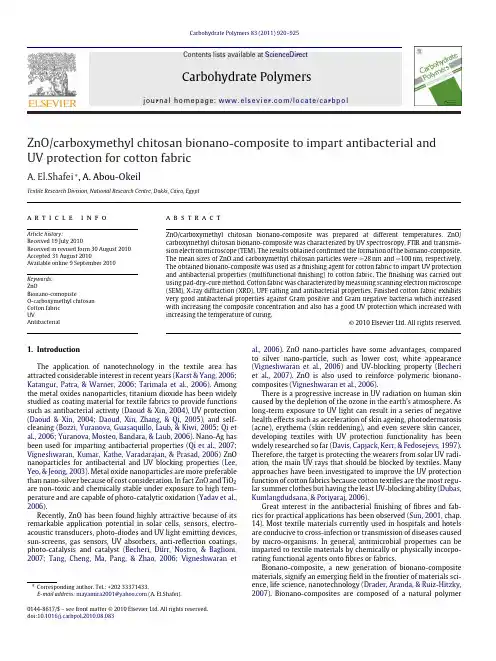纳米氧化锌PPT课件
- 格式:ppt
- 大小:3.78 MB
- 文档页数:47


纳米氧化锌介绍与应用纳米氧化锌(ZnO)粒径介于1-100 nm之间,是一种面向21世纪的新型高功能精细无机产品,表现出许多特殊的性质,如非迁移性、荧光性、压电性、吸收和散射紫外线能力等,利用其在光、电、磁、敏感等方面的奇妙性能,可制造气体传感器、荧光体、变阻器、紫外线遮蔽材料、图像记录材料、压电材料、压敏电阻、高效催化剂、磁性材料和塑料薄膜等。
概述中文名:纳米氧化锌英文名:Zinc oxide,nanometer 别名:纳米锌白;Zinc White nanometer CAS RN.:1314-13-2 分子式:ZnO 分子量:81.37形态纳米氧化锌是一种多功能性的新型无机材料,其颗粒大小约在1~100纳米。
由于晶粒的细微化,其表面电子结构和晶体结构发生变化,产生了宏观物体所不具有的表面效应、体积效应、量子尺寸效应和宏观隧道效应以及高透明度、高分散性等特点。
近年来发现它在催化、光学、磁学、力学等方面展现出许多特殊功能,使其在陶瓷、化工、电子、光学、生物、医药等许多领域有重要的应用价值,具有普通氧化锌所无法比较的特殊性和用途。
纳米氧化锌在纺织领域可用于紫外光遮蔽材料、抗菌剂、荧光材料、光催化材料等。
由于纳米氧化锌一系列的优异性和十分诱人的应用前景,因此研发纳米氧化锌已成为许多科技人员关注的焦点。
纳米氧化锌金属氧化物粉末如氧化锌、二氧化钛、二氧化硅、三氧化二铝及氧化镁等,将这些粉末制成纳米级时,由于微粒之尺寸与光波相当或更小时,由于尺寸效应导致使导带及价带的间隔增加,故光吸收显著增强。
各种粉末对光线的遮蔽及反射效率有不同的差异。
以氧化锌及二氧化钛比较时,波长小于350纳米(UVB)时,两者遮蔽效率相近,但是在350~400nm(UVA)时,氧化锌的遮蔽效率明显高于二氧化钛。
同时氧化锌(n=1.9)的折射率小于二氧化钛(n=2.6),对光的漫反射率较低,使得纤维透明度较高且利于纺织品染整。
纳米氧化锌还可用来制造远红外线反射纤维的材料,俗称远红外陶瓷粉。







纳米氧化锌材料本页仅作为文档页封面,使用时可以删除This document is for reference only-rar21year.March纳米氧化锌材料研究现状[摘要]总之,纳米ZnO作为一种新型无机功能材料,从它的许多独特的用途可发现其在日常生活和科研领域具有广阔的市场和诱人的应用前景。
随着研究的不断深入与问题的解决,将有更多的优异性能将会被发现。
同时更为廉价的工业化生产方法也将会成为现实,纳米ZnO材料将凭借其独特的性能进入我们的日常生活。
随着科技的发展,相信纳米ZnO材料的性能及应用将会得到更大的提高和普及,并在新能源、环保、信息科学技术、生物医学、安全、国防等领域发挥重要的作用。
[关键词]纳米ZnO; 表面效应; 溶胶-凝胶法;纳米复合材料一、纳米氧化锌体的制备目前,制备纳米氧化锌的方法很多,归纳起来有属于液相法的沉淀法、溶胶-凝胶法、水热法、溶剂热法等,也有属于气相法的化学气相反应法等,而固相法在纳米氧化锌的制备领域则较少见。
a、沉淀法沉淀法是指使用某些沉淀剂如OH-、CO32-、C2O42-等,或在一定的温度下使溶液发生水解反应,从而析出产物,洗涤后得到产品[2]。
沉淀法一般有分为均匀沉淀法、络合沉淀法、共沉淀法等。
均匀沉淀法工艺成本低、工艺简单,为研究纳米氧化锌结构与性能及应用之间的关系提供了方便。
曾宪华[3]等人以常见且廉价的六水硝酸锌和氢氧化钠为以甲醇溶液作为溶剂在常温常压条件下,用均匀沉淀法直接制备了平均粒径为11 nm的纳米氧化锌粉体。
以下是他们的用共沉淀法制备的纳米ZnO 的扫描电子显微镜(SEM)照片。
络合沉淀法,制备的纳米Zn0不团聚,分散性好,粒径均匀。
李冬梅[4]等人采用络合沉淀法制备了粉体平均粒径52 nm,分散性好的纳米氧化锌粉体,并对产品结构性能进行了表征。
所得ZnO粉体平均粒径48 nm.分散性好,收率高。
共沉淀法是将含两种或两种以上的阳离子加入到沉淀剂中,使所有的离子同时完全沉淀。


Carbohydrate Polymers 83 (2011) 920–925Contents lists available at ScienceDirectCarbohydratePolymersj o u r n a l h o m e p a g e :w w w.e l s e v i e r.c o m /l o c a t e /c a r b p olZnO/carboxymethyl chitosan bionano-composite to impart antibacterial and UV protection for cotton fabricA.El.Shafei ∗,A.Abou-OkeilTextile Research Division,National Research Centre,Dokki,Cairo,Egypta r t i c l e i n f o Article history:Received 19July 2010Received in revised form 30August 2010Accepted 31August 2010Available online 9 September 2010Keywords:ZnOBionano-comopisteO-carboxymethyl chitosan Cotton fabric UVAntibacteriala b s t r a c tZnO/carboxymethyl chitosan bionano-composite was prepared at different temperatures.ZnO/carboxymethyl chitosan bionano-composite was characterized by UV spectroscopy,FTIR and transmis-sion electron microscope (TEM).The results obtained confirmed the formation of the bionano-composite.The mean sizes of ZnO and carboxymethyl chitosan particles were ≈28nm and ≈100nm,respectively.The obtained bionano-composite was used as a finishing agent for cotton fabric to impart UV protection and antibacterial properties (multifunctional finishing)to cotton fabric.The finishing was carried out using pad-dry-cure method.Cotton fabric was characterized by measuring scanning electron microscope (SEM),X-ray diffraction (XRD),UPF ratting and antibacterial properties.Finished cotton fabric exhibits very good antibacterial properties against Gram positive and Gram negative bacteria which increased with increasing the composite concentration and also has a good UV protection which increased with increasing the temperature of curing.© 2010 Elsevier Ltd. All rights reserved.1.IntroductionThe application of nanotechnology in the textile area has attracted considerable interest in recent years (Karst &Yang,2006;Katangur,Patra,&Warner,2006;Tarimala et al.,2006).Among the metal oxides nanoparticles,titanium dioxide has been widely studied as coating material for textile fabrics to provide functions such as antibacterial activity (Daoud &Xin,2004),UV protection (Daoud &Xin,2004;Daoud,Xin,Zhang,&Qi,2005),and self-cleaning (Bozzi,Yuranova,Guasaquillo,Laub,&Kiwi,2005;Qi et al.,2006;Yuranova,Mosteo,Bandara,&Laub,2006).Nano-Ag has been used for imparting antibacterial properties (Qi et al.,2007;Vigneshwaran,Kumar,Kathe,Varadarajan,&Prasad,2006)ZnO nanoparticles for antibacterial and UV blocking properties (Lee,Yeo,&Jeong,2003).Metal oxide nanoparticles are more preferable than nano-silver because of cost consideration.In fact ZnO and TiO 2are non-toxic and chemically stable under exposure to high tem-perature and are capable of photo-catalytic oxidation (Yadav et al.,2006).Recently,ZnO has been found highly attractive because of its remarkable application potential in solar cells,sensors,electro-acoustic transducers,photo-diodes and UV light emitting devices,sun-screens,gas sensors,UV absorbers,anti-reflection coatings,photo-catalysis and catalyst (Becheri,Dürr,Nostro,&Baglioni,2007;Tang,Cheng,Ma,Pang,&Zhao,2006;Vigneshwaran et∗Corresponding author.Tel.:+20233371433.E-mail address:mayamira2001@ (A.El.Shafei).al.,2006).ZnO nano-particles have some advantages,compared to silver nano-particle,such as lower cost,white appearance (Vigneshwaran et al.,2006)and UV-blocking property (Becheri et al.,2007).ZnO is also used to reinforce polymeric bionano-composites (Vigneshwaran et al.,2006).There is a progressive increase in UV radiation on human skin caused by the depletion of the ozone in the earth’s atmosphere.As long-term exposure to UV light can result in a series of negative health effects such as acceleration of skin ageing,photodermatosis (acne),erythema (skin reddening),and even severe skin cancer,developing textiles with UV protection functionality has been widely researched so far (Davis,Capjack,Kerr,&Fedosejevs,1997).Therefore,the target is protecting the wearers from solar UV radi-ation,the main UV rays that should be blocked by textiles.Many approaches have been investigated to improve the UV protection function of cotton fabrics because cotton textiles are the most regu-lar summer clothes but having the least UV-blocking ability (Dubas,Kumlangdudsana,&Potiyaraj,2006).Great interest in the antibacterial finishing of fibres and fab-rics for practical applications has been observed (Sun,2001,chap.14).Most textile materials currently used in hospitals and hotels are conducive to cross-infection or transmission of diseases caused by micro-organisms.In general,antimicrobial properties can be imparted to textile materials by chemically or physically incorpo-rating functional agents onto fibres or fabrics.Bionano-composite,a new generation of bionano-composite materials,signify an emerging field in the frontier of materials sci-ence,life science,nanotechnology (Drader,Aranda,&Ruiz-Hitzky,2007).Bionano-composites are composed of a natural polymer0144-8617/$–see front matter © 2010 Elsevier Ltd. All rights reserved.doi:10.1016/j.carbpol.2010.08.083A.El.Shafei,A.Abou-Okeil/Carbohydrate Polymers83 (2011) 920–925921matrix and organic/inorganicfiller with at least one dimension on the nanometer scale.These bionano-composites show the remark-able advantages of biodegradability and biocompatibility in various medical,agricultural,drug release and packaging applications (Mangiacapra,Gorrasi,Sorrentino,&Vittoria,2006).Chitosan is a promising polymer matrix for such materials and a powerful chelating agent.In addition to its biodegradability and biocompatibility,this polymer can form various chemical bonds with transition metals and heavy metals components of com-posite materials and,thus,can enhance the stability of the nano particles.The use of biodegradable polymers is generally limited and by their poor physical and mechanical characteristics by dif-ficulty of processing.This observation refers in full measure to polysaccharides,which are infusible and sparingly soluble poly-mers;therefore,the design of composite materials on their basis requires new approaches to be advanced.This paper focuses on the preparation and characterization of ZnO/carboxymethyl chitosan bionano-composite.Application of bionano-composite to textile materials aimed at producing func-tional textiles by the pad-dry-cure method to impart UV and antibacterial activity to cotton fabric.2.Experimental2.1.MaterialsBleached100%cotton fabric was kindly supplied by Misr Com-pany for spinning and weaving Mehalla El Kobra,Egypt.Chitosan water soluble supplied by Fluka Company.ZnSO4·7H2O,NaOH, glacial acetic acid,monochloroacetic acid and isopropyl alcohol are of laboratory grade chemicals.2.2.Preparation of water soluble carboxymethyl chitosan(N/O-CM-chitosan)The experimental technique adopted for carboxymethylation of chitosan was as follows:certain volume of sodium hydroxide solution(30%,w/v)was added to16g chitosan suspended in iso-propyl alcohol.The mixture was left under stirring for30min at room temperature.To this mixture,34g of monochloroacetic acid was added and the content of theflask was subjected to contin-uous stirring for3h.At the end,the excess alkali was neutralized using glacial acetic acid and the chitosan was precipitated by adding acetone.Finally,the modified chitosan wasfiltered and washed with isopropyl alcohol/water(70:30)five times and dried at60◦C. Thefinal product was soluble in water(El-Shafei,Fouda,Knittel,& Schollmeyer,2008).2.3.Preparation of ZnO/(N/O-CM-chitosan)bionano-composite3g of N/O-CM-chitosan was dissolved in500ml of distilled water.The mixture was stirred using magnetic stirrer until com-plete dissolution of N/O-CM-chitosan.15g of ZnSO4·7H2O was added to the solution of N/O-CM-chitosan and stirred vigorously for 15min.4g of NaOH was dissolved in500ml of distilled water and added drop wise with constant stirring.The mixture was stirred for2h at25◦C,50◦C and90◦C.To obtain ZnO/N/O-CM-chitosan bionano-composite powder,the solution was decanted andfinally filtered off.The obtained powder was washed3times with distilled water to remove any impurities andfinally dried at80◦C for3h to complete the conversion of Zn(OH)2to ZnO nanoparticles.2.4.Application of ZnO/(N/O-CM-chitosan)bionano-composite to cotton fabricSuspensions of different concentrations of the bionano-composite(2–6%)were prepared in distilled water and sonicated for about15min.Cotton fabric was immersed in these suspen-sions and padded to pick up100%,dried at100◦C for5min and finally cured at160◦C for3min.The cotton fabrics were washed thoroughly with water and dried in open air.2.5.CharacterizationFTIR spectroscopy:FTIR spectroscopy was measured using FT-IR-FT-Raman,model:Nexus670(Nicollet-Madison-WI-USA).Cotton fabric was cut into very small pieces;these pieces were mixed with KBr.The spectral range was400–4000cm−1.Scanning electron microscope(SEM),the samples were examined by a JEOL–840X scanning electron microscope,from Japan,mag-nification range35–10,000,resolution200˚A,acceleration voltage 19kV.All the samples were coated with gold before SEM testing.Transmission electron microscope(TEM)was measured using Zeiss-EM10-Germany.X-ray diffraction(XRD):X-ray diffractometer model Philips X’Pert MPP with a type PW3050/10goniometer.The diffractometer controlled and operated by a PC computer with the programs P Rofit and used a Mo K(source with wavelength0.70930˚A,operating with Mo-tube radiation at50kV and40mA.The scan parameters range from2◦<2(<50◦with scanning step of0.03in the reflection geometry.UV–vis spectrum:UV–vis spectrum was recorded on Perkin Elmer Lambda3B UV-Vis spectrometer.UPF rating and UV transmittance were measured using UV-Shimadzu3101PC-Spectrophotometer.Antibacterial test:for antibacterial experiment,Staphylococcus aureus(S.aureus,Gram-positive bacteria)and Escherichia coli(E. coli,Gram-negative bacteria)were used.The antibacterial activity of prepared cotton samples was measured by the inhibition zone method.3.Results and discussion3.1.Characterization of carboxymethyl chitosan(N/O-CM-chitosan)by solid state13C NMRCarboxymethylation of chitosan is achieved with monochloroacetic acid and sodium hydroxide.According to this reaction takes place preferentially either at C-6hydroxyl groups or at the NH2-group resulting in N/O-carboxymethyl chitosan(N/O-CM-chitosan).The solid state13C NMR spectrum for a typical N-carboxymethyl chitosan shows signals attributed to the N-carboxymethyl substituent,at47.7and168.7ppm,for N-CH2and COOH,respectively,but in case of our results,the solid state13C NMR described in Fig.1shows signals at73and 175ppm which attributed to–O-CH2–and COOH carboxyl group, respectively.This downfield shift of the carbon indicates the formation of O-carboxymethyl chitosan.The formation of this product agrees with the higher reactivity of hydroxyl group of C6 in this heterogeneous reaction.The N-carboxymethyl substituent is not present because of the absence of peaks at47and168ppm for N-CH2and COOH,respectively.3.2.Characterization of ZnO/(N/O-CM-chitosan)bionano-compositeZnO/(N/O-CM-chitosan)bionano-composite was characterized by UV–vis spectroscopy,TEM,XRD and FTIR.3.2.1.UV spectroscopyUV–vis spectra of ZnO/(N/O-CM-chitosan)bionano-composite prepared at25◦C,50◦C and are shown in Fig.2.It is clear from Fig.1922 A.El.Shafei,A.Abou-Okeil /Carbohydrate Polymers83 (2011) 920–925Fig.1.Solid state 13C NMR spectrum typical for O-carboxymethylchitosan.Fig.2.UV spectroscopy of ZnO/CMCTS bionano-composite.that the absorption peaks for ZnO/(N/O-CM-chitosan)bionano-composite are 310nm and 300nm for the samples prepared at 25◦C and 50◦C,respectively,while the peak of bulk ZnO is at 380nm which means that by increasing the temperature leads to increas-ing the concentration of ZnO nanoparticles and decreasing of its particle size.This finding confirms the role of the temperature on the formation of ZnO nanoparticles which facilitate the formation of nanoparticles and prevent its aggregation.3.2.2.TEMFig.3a and b shows the TEM of ZnO/N/O-CM-CHITOSAN bionano-composite prepared at 50◦C and 25◦C,respectively.It is shown by Fig.3a and b that ZnO nanoparticles (black dots)prepared at 50◦C seem to be spherical in shape,homogeneous (Fig.3a)and of particle size smaller than that prepared at 25◦C (the mean particle size is of 28nm).Also the size of N/O-CM-chitosan particles (white dots)is of about 100nm in size,and also in spherical and homoge-neous in shape.According to the presence of NH 2and COOH groups in N/O-CM-chitosan,N/O-CM-chitosan seems to act as stabilizer and/or a template of the formation of ZnO nanoparticles,through the formation of coordination bonds with Zn 2+(Raveendran,Fu,&Wallen,2003;Taubert &Wegner,2002).3.2.3.FTIR spectroscopyThe composition of ZnO/(N/O-CM-chitosan)bionano-composite was confirmed by FTIR spectroscopy.Fig.4a and b shows FTIR spectra of N/O-CM-chitosan alone and ZnO/(N/O-CM-chitosan)bionano-composite.As shown in Fig.4a the absorption peak at about 1400cm −1and 1600cm −1are corresponding to carboxyl groups (Rosca,Popa,Lisa,&Chitanu,2005).And the peak at about 2900cm −1is attributed to C–H stretching.A broad band at about 3447cm −1is attributed to OH and NH 2of chitosan.FTIR spectrum of ZnO/(N/O-CM-chitosan)bionano-composite (Fig.4b)is similar to that of N/O-CM-chitosan and the band at about 516cm −1is corresponding toZnO.Fig.3.(a and b)TEM of ZnO/CMCTS bionano-composite prepared at 50◦C and 25◦C,respectively.A.El.Shafei,A.Abou-Okeil/Carbohydrate Polymers83 (2011) 920–925923Fig.4.(a and b)FTIR of carboxymethyl chitosan and ZnO/CMCTS bionano-composite.3.3.Characterization of cotton fabric treated with theZnO/N/O-CM-chitosan bionano-compositeCotton fabrics were characterized by measuring antibacterial properties,UPF ratting,UV transmittance.XRD and SEM.3.3.1.XRDThe XRD pattern of cotton fabric treated with2%ZnO/(N/O-CM-chitosan)bionano-composite is shown in Fig.5.The characteristic peaks of cotton fabric(Fig.5)at2Â≈23◦which is the intensive peak, and also the less intensive one at2Â≈14◦(Swarthmore,1972).The other bands at2Âless than24are may be attributed to the presence of N/O-CM-chitosan.The broad beak at2Âfrom31◦to36◦is related to the ZnO crystallite(Swarthmore,1988).This broadening is may attributed to the presence of Zn in coordination with NH2and COOH groups present in the N/O-CM-chitosan moieties.3.3.2.SEMSEM was used to characterize the surface of cotton fabric treated with ZnO/(N/O-CM-chitosan)bionano-composite.SEM images of treated cotton fabric and untreated sample are shown in Fig.6a and b.It is shown that cotton fabric is treated with a uniform and dense film(black)of ZnO nanoparticles(with mean size=28nm)(Fig.6a), while the larger particles(white)are of the larger particles of N/O-CM-chitosan polymer molecules which are of the range100nm in size.3.3.3.Antibacterial propertiesThe antibacterial activity of cotton fabrics was resulted from the presence of ZnO/(N/O-CM-chitosan)bionano-composite on their surface.Antibacterial properties of cotton fabric treated with ZnO/(N/O-CM-chitosan)bionano-composite are measured accord-ing to the inhibition zone method against Gram negativebacteria Fig.5.XRD of cotton fabric treated with ZnO/CMCTS bionano-composite.924 A.El.Shafei,A.Abou-Okeil/Carbohydrate Polymers83 (2011) 920–925Fig.6.SEM of cotton fabric and cotton fabric treated with ZnO/CMCTS bionano-composite(a)treated,(b)untreated.(E.coli)and Gram positive one(S.aureus).Table1shows the results of inhibition zone of treated cotton fabrics with different concen-trations of ZnO/N/O-CM-chitosan bionano-composite in the range 2–6%.Table1clearly says that all samples have inhibition zone larger than the untreated sample which is obvious from Table1 and Fig.6.Also Table1shows that the zone increases with increas-ing the ZnO/(N/O-CM-chitosan)bionano-composite concentration in the range studied(2–6%).Table1shows the larger resistivity of the E.coli(Gram negative bacteria)compared to the S.aureus (Gram positive bacteria)which is related to the differences in the structures of each type.3.3.4.UPF and UV transmittanceTable2shows the UPF rating values of the treated cotton fabrics with2%of the composite at different curing tempera-tures(120–160◦C).UPF rating values of the treated sample are greater than of the untreated sample.Also UPF values increase with increasing the curing temperature in the range studied as show byTable1Inhibition zone diameter of cotton fabric.Concentration of composite%Inhibition zone diameter(mm/1cm sample)Escherichia coli(G−)Staphylococcus aureus(G+)Control0.00.026124222662225Cotton fabric treated with different concentrations of ZnO-CMCTS bionano-composite,100%pick-up,dried at100◦C for5min cured at160◦C.Table2UPF ratting of cotton fabric.Curing temperature UPF rattingControl5120◦C 5.7140◦C 6.4160◦C7.6Cotton fabric treated with2%ZnO-CMCTS bionano-composite,100%pick-up,dried at100◦C for5min cured at different curing temperatures.Table2.Thisfinding may be attributed to increasing the concentra-tion of ZnO by conversion of the remained Zn(OH)2to ZnO under the influence of the higher temperature.UPF values are5.7,6.4and 7.6at curing temperatures120◦C,140◦C and160◦C,respectively. Also the UV transmittance(in the range200–400nm)of the treated sample at different curing temperature decreases with increasing curing temperature which is congruent with the results of UPF and also attributed to the same reason.4.ConclusionIn conclusion,a simple method has been developed to prepare nano-ZnO by using ZnO/carboxymethyl chitosan bionano-composite system and coat the same on cotton fabrics to impart functional properties.The optimum reaction was proceeding at50◦C results in the formation of smaller nanoparticles with respect to the reaction carried out in water at25or90◦C.In both cases,the nanoparti-cles appear to be nearly spherical and with a quite narrow size range.The mean sizes of ZnO and carboxymethyl chitosan parti-cles was≈28nm and≈100nm,respectively.Nanoparticles were analyzed through electron microscopy,X-ray diffraction,FTIR,and specific surface area experiments.The peculiar performance of ZnO nanoparticles as UV-absorbers can be efficiently transferred to fab-ric materials through the application of ZnO nanoparticles on the surface of cotton fabrics.The UV tests indicate a significant incre-ment of the UV absorbing activity in the ZnO-treated fabrics.Also the treated fabric with indicate significant improve for antibacte-rial properties for cotton fabric.Such result can be exploited for the protection of the body against solar radiation,bacterial action and for other technological applications.ReferencesBecheri,A.,Dürr,M.,Nostro,P.L.,&Baglioni,P.(2007).Synthesis and characterization of zinc oxide nanoparticles:application to textiles as UV-absorbers.Journal of Nanoparticles Research,10,679–689.Bozzi,A.,Yuranova,T.,Guasaquillo,I.,Laub,F.,&Kiwi,J.(2005).Self-cleaning of modified cotton textiles by TiO2at low temperatures under daylight irradiation.Journal of Photochemistry and Photobiology A-Chemistry,174,156.Daoud,W.A.,&Xin,J.H.(2004).Low temperature sol–gel processed photocatalytic titania coating.Journal of Sol–Gel Science and Technology,29,25.Daoud,W.A.,Xin,J.H.,Zhang,Y.H.,&Qi,K.(2005).Surface characterization of thin titaniafilms prepared at low temperatures.Journal of Non-Crystalline Solids,351, 16–17,1486–1490.Davis,S.,Capjack,L.,Kerr,N.,&Fedosejevs,R.(1997).Clothing as protection from ultraviolet radiation:Which fabric is most effective.International Journal of Der-matology,36,374–379.Drader,M.,Aranda,P.,&Ruiz-Hitzky,E.(2007).Bionanocomposites:A new concept of ecological,bioinspired,and functional hybrid materials.Advanced Material, 19,1309.Dubas,S.T.,Kumlangdudsana,P.,&Potiyaraj,P.(2006).Layer-by-layer deposition of antimicrobial silver nanoparticles on textilefibers.Colloids and Surfaces A: Physicochemical and Engineering Aspects,289,105–109.El-Shafei,A.,Fouda,M.G.,Knittel,D.,&Schollmeyer,E.(2008).Antibacterial activity of cationically modified cotton fabric with carboxymethyl chitosan.Journal of Applied Polymer Science,110,1289.Karst,D.,&Yang,Y.(2006).AATCC Review,6,44.Katangur,P.,Patra,P.K.,&Warner,S.B.(2006).Nanostructured ultraviolet resistant polymer coatings.Polymer Degradation and Stability,91,2437.Lee,H.J.,Yeo,S.Y.,&Jeong,S.H.(2003).Antibacterial effect of nanosized silver colloidal solution on textile fabrics.Journal of Materials Science,38,2199.A.El.Shafei,A.Abou-Okeil/Carbohydrate Polymers83 (2011) 920–925925Mangiacapra,P.,Gorrasi,G.,Sorrentino,A.,&Vittoria,V.(2006).Biodegradable nanocomposites obtained by ball milling of pectin and montmorillonites.Car-bohydrate polymers,64,516.Qi,K.,Chen,X.,Liu,Y.,Xin,J.H.,Mak,C.L.,&Daoud,W.A.(2007).Facile preparation of anatase/SiO2spherical nanocomposites and their application in self-cleaning textiles.Journal of Materials Chemistry,17,3504.Qi,K.,Daoud,W.A.,Xin,J.H.,Mak,C.L.,Tang,W.,&Cheung,W.P.(2006).Self-cleaning cotton.Journal of Materials Chemistry,16,4567.Raveendran,P.,Fu,J.,&Wallen,S.L.(2003).Completely“Green”synthesis and stabi-lization of metal nanoparticles.Journal of American Chemical Society,12513940. Rosca, C.,Popa,M.I.,Lisa,G.,&Chitanu,G. C.(2005).Interaction of chi-tosan with natural or synthetic anionic polyelectrolytes. 1.The chitosan–carboxymethylcellulose complex.Carbohydrate Polymers,62,35.Sun,G.(2001).Bioactivefibres and polymers.In J.V.Edwards,&T.L.Vigo(Eds.),ACS symposium series792.Washington,DC:American Chemical Society. Swarthmore,P.A.(1972).Powder diffractionfile,joint committee on powder diffraction standards.International Center for Diffraction data.Card3-0226. Swarthmore,P.A.(1988).Powder diffractionfile,joint committee on powder diffraction standards.International Center for Diffraction data.Card38-0356.Tang,E.,Cheng,G.,Ma,X.,Pang,X.,&Zhao,Q.(2006).Surface modification of zinc oxide nanoparticle by PMAA and its dispersion in aqueous system.Applied Sur-face Science,252,5227–5232.Tarimala,S.,Kothari,N.,Abidi,N.,Hequet,E.,Fralick,J.,&Dai Lenore,L.(2006).New approach to antibacterial treatment of cotton fabric with silver nanoparticle-doped silica using sol–gel process.Journal of Applied Polymer Science,101, 2938.Taubert,A.,&Wegner,G.(2002).Formation of uniform and monodisperse zincite crystals in the presence of soluble starch.Journal of Materials Chemistry, 12,805.Vigneshwaran,N.,Kumar,S.,Kathe,A.A.,Varadarajan,P.V.,&Prasad,V.(2006).Functionalfinishing of cotton fabrics using zinc oxide-soluble starch nanocom-posites.Nanotechnology,17,5087–5095.Yadav,A.,Prasad,V.,Kathe,A.A.,Raj,S.,Yadav,D.,Sundaramoorthy,C.,et al.(2006).Functionalfinishing in cotton fabrics using zinc oxide nanoparticles.Bulletin of Materials Science,29,641.Yuranova,T.,Mosteo,R.,Bandara,J.,&Laub,D.J.(2006).Self-cleaning cotton tex-tiles surfaces modified by photoactive SiO2/TiO2coating.Journal of Molecular Catalysis A-Chemistry,244,160.。
纳米氧化锌/SSBR复合材料导热性能的研究轮胎等橡胶制品在使用过程中,由于滞后损失产生大量热量,这些热量如果不能及时散出,将导致制品内部温度过高而使其性能下降。
提高橡胶材料的导热性能,可使材料在使用过程中产生的热量及时散失,减少热量的积累,保证橡胶制品的正常使用。
热导率是表征橡胶制品导热性能的重要参数,提高橡胶材料热导率最常用的方法是添加导热粒子。
氧化锌与硬脂酸并用可作为橡胶加工活性剂。
氧化锌大量填充时,可起橡胶补强剂的作用。
与普通氧化锌相比,纳米氧化锌具有高结构特征。
据报道,纳米氧化锌能提高硫化反应活性,延长胶料的正硫化时间,减少橡胶硫化产生不稳定的多硫交联键、提高胶料的物理性能和热稳定性。
此外,纳米氧化锌具有良好的导热性能,热导率为25 W·(m·K)-1。
溶聚丁苯橡胶(SSBR)具有相对分子质量大和相对分子质量分布窄等特点,滞后损失较小,广泛应用于低滚动阻力轮胎胶料,但SSBR的热导率仅为0.125 W·(m·K)-1,因此,需提高其热导率。
本工作以纳米氧化锌为导热填料,制备纳米氧化锌/SSBR复合材料,并研究纳米氧化锌用量对复合材料物理性能、导热性能和网络结构的影响。
1 实验1.1 主要原材料SSBR,牌号2305,聚苯乙烯的质量分数为0.256 4,聚丁二烯质量分数为0.743 6(其中顺式1,4-聚丁二烯、反式1,4-聚丁二烯和1,2-聚丁二烯的质量分数分别为0.241 4,0.396 4和0.3621),玻璃化温度为-50.5℃,中国石化北京燕山石油化工股份有限公司合成橡胶厂产品;纳米氧化锌,美国西格玛化学有限公司产品。
1.2 基本配方SSBR 100,普通氧化锌5,硬脂酸2,防老剂4010A 1,防老剂RD 1,硫黄 2.5,促进剂CZ 1.8,促进剂TMTD 0.2,纳米氧化锌变量。
1.3 试样制备采用JIC-725型两辊开炼机(广东省湛江机械厂产品)对SSBR进行塑炼,依次加入活性剂、防老剂、促进剂和纳米氧化锌,待纳米氧化锌混炼均匀后,再加入硫黄混炼,然后薄通、打三角包,下片,停放24 h。
Since the discovery of oxide nanobelts of semiconducting oxides in 20011, research into functional oxide-based, one-dimensional nanostructures has rapidly expanded because of their unique and novel applications in optics,optoelectronics, catalysis, and piezoelectricity.Semiconducting oxide nanobelts are a unique group of quasi-one-dimensional nanomaterials, which have been systematically studied for a wide range of materials with distinct chemical compositions and crystallographic structures.Belt-like, quasi-one-dimensional nanostructures (called nanobelts) have been synthesized for semiconducting oxides of Zn, Sn, In, Cd, and Ga, by simply evaporating the desired commercial metal oxide powders at high temperatures. The as-synthesized oxide nanobelts are pure, structurally uniform,single-crystalline, and mostly free from dislocations; they have a rectangular-like cross-section with constantdimensions. The belt-like morphology appears to be a unique and common structural characteristic of this family of semiconducting oxides with cations of different valence states and materials of distinct crystallographic structures.Field-effect transistors 2, ultrasensitive nano-sized gassensors 3, nanoresonators 4, and nanocantilevers 5have been fabricated based on individual nanobelts. Thermal transport along the nanobelt has also been measured 6. Very recently,nanobelts, nanosprings 7, and nanorings 8that exhibitpiezoelectric properties have been synthesized, which could be candidates for nanoscale transducers, actuators, and sensors.by Zhong Lin WangNanostructuresof zinc oxideSchool of Materials Science and Engineering, Georgia Institute of Technology, Atlanta, GA 30332-0245 USAE-mail: zhong.wang@June 200426ISSN:1369 7021 © Elsevier Ltd 2004Zinc oxide (ZnO) is a unique material that exhibits semiconducting, piezoelectric, and pyroelectric multiple properties. Using a solid-vapor phase thermal sublimation technique, nanocombs,nanorings, nanohelixes/nanosprings, nanobows,nanobelts, nanowires, and nanocages of ZnO have been synthesized under specific growth conditions.These unique nanostructures unambiguouslydemonstrate that ZnO is probably the richest family of nanostructures among all materials, both in structures and properties. The nanostructures could have novel applications in optoelectronics, sensors,transducers, and biomedical science because it is bio-safe.REVIEW FEATUREAmong the functional oxides with perovskite, rutile, CaF 2,spinel, and wurtzite structures 9, ZnO is unique because it exhibits dual semiconducting and piezoelectric properties.ZnO is a material that has diverse structures, whose configurations are much richer than any knownnanomaterials including carbon nanotubes. Using a solid-state thermal sublimation process and controlling the growth kinetics, local growth temperature, and the chemical composition of the source materials, a wide range ofnanostructures of ZnO have been synthesized (Fig. 1). This review focuses on the formation of nanohelixes, nanobows,nanopropellers, nanowires, and nanocages of ZnO.Nanohelixes/nanosprings and seamless nanoringsThe wurtzite structure family has a few important members,such as ZnO, GaN, AlN, ZnS, and CdSe, which are importantmaterials for applications in optoelectronics, lasing, and piezoelectricity. The two important characteristics of the wurtzite structure are the noncentral symmetry and polar surfaces. The structure of ZnO, for example, can be described as a number of alternating planes composed of tetrahedrally coordinated O 2-and Zn 2+ions, stacked alternately along the c -axis (Fig. 2a ). The oppositely charged ions produce positively charged (0001)-Zn and negatively charged(0001)-O polar surfaces, resulting in a normal dipole moment and spontaneous polarization along the c -axis, as well as a divergence in surface energy.By adjusting the raw materials with the introduction of impurities, such as In, we have synthesized a nanoring structure of ZnO (Fig. 2)8. High-magnification scanning electron microscopy (SEM) images clearly show the perfect circular shape of the complete ring, with uniform shape andflat surfaces. Transmission electron microscopy (TEM) imagesFig. 1 A collection of nanostructures of ZnO synthesized under controlled conditions by thermal evaporation of solid powders. Most of the structures presented can be produced with 100%purity.June 200427indicate that the nanoring is a single-crystal entity with a circular shape. The single-crystal structure referred to here means a complete nanoring made of a single-crystalline ribbon bent evenly at the curvature of the nanoring. Thenanoring is the result of coaxial, uniradius, epitaxial coiling of a nanobelt.The growth of nanoring structures can be understood by considering the polar surfaces of the ZnO nanobelt. The polar nanobelt, which is the building block of the nanoring, growsalong [1010], with side surfaces ±(1210) and top/bottom surfaces ±(0001), and has a typical width of ~15 nm and thickness of ~10 nm. The nanobelt has polar charges on its top and bottom surfaces (Fig. 2b ). If the surface charges are uncompensated during growth, the nanobelt may tend to fold itself, as it lengthens, to minimize the area of the polar surface. One possible way is to interface the positively charged (0001)-Zn plane (top surface) with the negatively charged (0001)-O plane (bottom surface), resulting in neutralization of the local polar charges and reduction of the surface area, thus forming a loop with an overlapped end (Fig. 2b ). The radius of the loop may be determined by the initial folding of the nanobelt during early growth, but the size of the loop cannot be too small to reduce the elastic deformation energy. The total energy involved in the process comes from the polar charges, surface area, and elasticdeformation. The long-range electrostatic interaction is likely to be the initial driving force for the folding of the nanobelt to form the first loop for subsequent growth. As the growth continues, the nanobelt may be naturally attracted onto the rim of the nanoring because of electrostatic interactions and may extend parallel to the rim of the nanoring to neutralize the local polar charge and reduce the surface area. This results in the formation of a self-coiled, coaxial, uniradius,multilooped nanoring structure (Fig. 2c ). The self-assembly is spontaneous, which means that the self-coiling along the rim proceeds as the nanobelt grows. The reduced surface areaREVIEW FEATUREJune 200428Fig. 2 Seamless single-crystal nanorings of ZnO. (a) Structure model of ZnO, showing the ±(0001) polar surfaces. (b-e) Proposed growth process and corresponding experimental results showing the initiation and formation of the single-crystal nanoring via the self-coiling of a polar nanobelt. The nanoring is initiated by folding a nanobelt into a loop with overlapped ends as a result of long-range electrostatic interactions among the polar charges; the short-range chemical bonding stabilizes the coiled ring structure; and the spontaneous self-coiling of the nanobelt is driven by minimization of the energy contributed by polar charges, surface area, and elastic deformation. (f) SEM images of the as-synthesized, single-crystal ZnO nanoring. (g) The ‘slinky’ growth model of the nanoring. (h) The charge model of an α-helix protein, in analogy to the charge model of the nanobelt during the self-coiling process.REVIEWFEATUREFig. 3 (a) Model of a polar nanobelt. Polar-surface-induced formation of (b) nanorings, (c) nanospirals, and (d) nanohelixes of ZnO and their formation processes.June 200429and the formation of chemical bonds (short-range forces)between the loops stabilize the coiled structure. The width of the nanoring increases as more loops wind along thenanoring axis, and all remain in the same crystal orientation (Fig. 2d ). Since the growth is carried out in a temperature region of 200-400°C, ‘epitaxial sintering’ of the adjacent loops forms a single-crystal cylindrical nanoring structure,and the loops of the nanobelt are joined by chemical bonds into a single entity (Fig. 2e ). A uniradius, perfectly aligned coiling is energetically favorable because of the complete neutralization of the local polar charges inside the nanoring (Fig. 2f ) and the reduced surface area. This is the ‘slinky’growth model of the nanoring shown in Fig. 2g . The charge model of the nanoring is analogous to the α-helix protein molecule (Fig. 2h ).We have recently synthesized ZnO nanobelts that are dominated by the (0001) polar surface 7. The nanobelt grows along [2110] (the a -axis), with its top/bottom surfaces thinness (5-20 nm) and large aspect ratio (~1:4), theflexibility and toughness of the nanobelts is extremely high. A polar-surface-dominated nanobelt can be approximated to be a capacitor with two parallel charged plates (Fig. 3a ). The polar nanobelt tends to roll over into an enclosed ring to reduce the electrostatic energy (Fig. 3b ). A spiral shape can also reduce the electrostatic energy (Fig. 3c ). The formation of the nanorings and nanohelixes can be understood from the nature of the polar surfaces. If the surface charges are uncompensated during the growth, the spontaneouspolarization induces electrostatic energy as a result of the dipole moment. But rolling up to form a circular ring would minimize or neutralize the overall dipole moment, reducing the electrostatic energy. On the other hand, bending the nanobelt produces elastic energy. The stable shape of the nanobelt is determined by the minimization of the total energy contributed by spontaneous polarization and elasticity.If the nanobelt is rolled uniradially loop-by-loop, the repulsive force between the charged surfaces stretches the nanohelix, while the elastic deformation force pulls the loops together; the balance between the two forms thenanohelix/nanospring shown in Fig. 3d . The nanohelix has a uniform shape with a radius of ~500-800 nm and evenly distributed pitches. Each is made of a uniformly deformed single-crystal ZnO nanobelt.The striking new feature of the nanorings and nanohelixes of single-crystalline ZnO nanobelts reported here is that they are spontaneous-polarization-induced structures, the result ofa 90° rotation in polarization. These are ideal objects for understanding piezoelectricity and polarization-induced phenomena at the nanoscale. The piezoelectric nanobelt structures could also be used as nanoscale sensors, transducers, or resonators.Aligned nanopropellersModifying the composition of the source materials can drastically change the morphology of the grown oxide nanostructure. We used a mixture of ZnO and SnO2powders in a weight ratio of 1:1 as the source material to grow a complex ZnO nanostructure10,11. Fig. 4a is an SEM image of the as-synthesized products showing a uniform feature consisting of sets of central axial nanowires, surrounded by radially oriented ‘tadpole-like’ nanostructures. The morphology of the string appears like a ‘liana’, while the axial nanowire is like ‘rattan’, which has a uniform cross-section with dimensions in the range of a few tens of nanometers. The tadpole-like branches have spherical balls at the tips (Fig. 4a), and the branches display a ribbon shape. The ribbon branches have a fairly uniform thickness, and their surfaces are rough with steps. Secondary growth on the ‘propeller’surface leads to aligned nanowires (Fig. 4b).It is known that SnO2can decompose into Sn and O2at high temperature, thus the growth of the nanowire-nanoribbon junction arrays is the result of the vapor-liquid-solid (VLS) growth process, in which Sn catalyst particles are responsible for initiating and leading the growth of ZnO nanowires and nanoribbons. The growth of the novel structures presented here can be separated into two stages. The first stage is fast growth of the ZnO axial nanowire along [0001] (Fig. 4c). The growth rate is so high that a slow increase in the size of the Sn droplet has little influence on the diameter of the nanowire, thus the axial nanowire has a fairly uniform shape along the growth direction. The second stage is the nucleation and epitaxial growth of nanoribbons as a result of the arrival of tiny Sn droplets onto the ZnO nanowire surface (Fig. 4d). This stage is much slower than the first one because the lengths of the nanoribbons are uniform and much shorter than that of the nanowire. Since Sn is in a liquid state at the growth temperature, it tends to adsorb the newly arriving Sn species and grows into a larger size particle (i.e. coalesces). Therefore, the width of the nanoribbon increases as the size of the Sn particle at the tip becomes larger, resulting in the formation of the tadpole-like structure observed in the TEM (Fig. 4e). The Sn liquid droplets deposited onto the ZnO nanowire lead to the simultaneous growth of ZnO nanoribbons along six equivalent growth directions: ±[1010], ±[0110], and ±[1100]. Secondary growth along [0001] results in the growth of aligned nanowires on the surfaces of the propellers (Fig. 4f).Patterned growth of aligned nanowires The growth of patterned and aligned one-dimensional nanostructures is important for applications in sensing2,3, optoelectronics, and field emission12,13. Aligned growth of ZnO nanorods has been successfully achieved on a solid substrate via the VLS process with the use of Au14,15andSn16as catalysts, which initiate and guide the growth. The epitaxial orientation relationship between the nanorods and the substrate leads to aligned growth. Other techniques that do not use catalysts, such as metalorganic vapor-phase epitaxial growth17, template-assisted growth12, and electrical field alignment18have also been employed for the growth of vertically aligned ZnO nanorods. Huang et al.have demonstrated a technique for growing periodically arranged carbon nanotubes using a catalyst pattern produced from aREVIEW FEATUREJune 200430Fig. 4 Nanopropeller arrays of ZnO. (a) SEM image of Sn-catalyzed growth of aligned nanopropellers based on the six equivalent crystallographic directions. (b) Secondary growth of nanowires on the surface of the nanopropellers. (c-f) Growth process of the nanopropellers.REVIEW FEATUREmask and self-assembled submicron spheres 19. We have combined this self-assembly-based mask technique with the surface epitaxial approach to grow large-area hexagonal arrays of aligned ZnO nanorods 20.The synthesis process involves three main steps. The hexagonally patterned ZnO nanorod arrays are grown on a single-crystal Al 2O 3substrate on which patterned Au catalyst particles have been dispersed. First, a two-dimensional, large-area, self-assembled and ordered monolayer of submicron polystyrene spheres is introduced onto the single-crystal Al 2O 3substrate (Fig. 5a ). Second, a thin layer of Au particles is deposited onto the self-assembled monolayer; the spheres are then etched away, leaving a patterned Au catalyst array (Fig. 5b ). Finally, nanowires are grown on the substrate using the VLS process (Fig. 5c ). The spatial distribution of the catalyst particles determines the pattern of the nanowires.This step can be achieved using a variety of masktechnologies for producing complex configurations. Bychoosing the optimum match between the substrate lattice and the nanowires, the epitaxial orientation relationshipbetween the nanowire and the substrate results in the aligned growth of nanowires normal to the substrate. The distribution of the catalyst particles defines the location of the nanowires, and the epitaxial growth on the substrate results in the vertical alignment.Mesoporous single-crystal nanowiresPorous materials have a wide variety of applications in bioengineering, catalysis, environmental engineering, and sensor systems because of their high surface-to-volume ratio.Normally, most of these mesoporous structures arecomposed of amorphous materials and porosity is achieved by solvent-based organic or inorganic reactions. There are few reports of mesoporous structures based on crystalline material.We have reported a novel wurtzite ZnO nanowire structure that is a single crystal but is composed ofmesoporous walls/volumes 21. The synthesis is based on a modified solid-vapor process. Fig. 6a shows an SEM image of the as-synthesized ZnO nanowires grown on a Si substrate coated with a thin layer of Sn catalyst. The typical length ofthe nanowires varies from 100 µm to 1 mm and the diameterFig. 5 Growth of patterned and aligned ZnO nanowires. (a) Self-assembled monolayer of polystyrene spheres that serves as a mask. (b) Hexagonally patterned Au catalyst on the substrate. (c) Aligned ZnO nanowires grown on a single-crystal alumina substrate in a honeycomb pattern defined by the catalyst mask.June 200431Fig. 6 Mesoporous, single-crystal ZnO nanowires. (a) SEM image of high-porosity ZnO nanowires grown on an Sn-coated Si substrate. (b) High-magnification SEM images showing the morphology of a single nanowire. (c) Low-magnification TEM image of a porous ZnO nanowire and corresponding electron diffraction pattern, showing that the ZnO porous wire is covered by a thin layer of Zn 2SiO 4.is in the range of 50-500 nm. The porous structure of the ZnO nanowires is apparent (Fig. 6b ). A corresponding electron diffraction pattern from the nanowire presents two sets ofZn 2with a standard deviation of ±1.5 nm, indicating a very good size uniformity.To examine size-induced quantum effects in the ultrathin ZnO nanobelts, photoluminescence (PL) measurements were performed at room temperature using an Xe lamp with an excitation wavelength of 330 nm (Fig. 7b ). In comparison with the PL measurements from nanobelts with an average width of ~200 nm, the 6 nm nanobelts show a 14 nm shift in the emission peak, which possibly indicates quantumconfinement arising from the reduced size of the nanobelts.Polyhedral cagesCages of ZnO have also been synthesized at a high yield and purity 23. The mesoporous-structured polyhedral drum and spherical cages and shells are formed by textured self-assembly of ZnO nanocrystals, which are made by a novel self-assembly process during epitaxial surface oxidation (Fig. 8) The cages and shells exhibit unique geometricalnanostructures has been grown. It canREVIEW FEATUREJune 200432Fig. 7 Ultra-narrow ZnO nanobelts. (a) TEM image of a ZnO nanobelt grown using a Sn thin-film catalyst. (b) PL spectra of the wide (W = 200 nm) and narrow nanobelts (W = 6 nm), showing the blue shift in the emission peak as a result of size effects.REVIEW FEATUREbe predicted that ZnO is probably the richest family of nanostructures among all one-dimensional nanostructures,including carbon nanotubes.ZnO has three key advantages. First, it is semiconductor,with a direct wide band gap of 3.37 eV and a large excitation binding energy (60 meV). It is an important functional oxide,exhibiting near-ultraviolet emission and transparentconductivity. Secondly, because of its noncentral symmetry,ZnO is piezoelectric, which is a key property in building electromechanical coupled sensors and transducers. Finally,ZnO is bio-safe and biocompatible, and can be used forbiomedical applications without coating. With these three unique characteristics, ZnO could be one of the mostimportant nanomaterials in future research and applications.The diversity of nanostructures presented here for ZnOshould open up many fields of research in nanotechnology. MTAcknowledgmentsThanks to Y. Ding, P. X. Gao, W. L. Hughes, X. Y. Kong, C. Ma, D. Moore, Z. W. Pan,C. J. Summers, X.D. Wang, and Y. Zhang for helpful discussion and their contributions to the work reviewed in this article. We acknowledge generous support by the Defense Advanced Projects Research Agency, National Science Foundation, and NASA.June 200433REFERENCES1.Pan, Z. W., et al ., Science (2001) 291, 19472.Arnold, M. S., et al., J. Phys. Chem. B (2003) 107(3), 659ini, E., et al., Appl. Phys. Lett.(2002) 81(10), 18694.Bai, X. D., et al., Appl. Phys. Lett.(2003) 82(26), 48065.Hughes, W. L., and Wang, Z. L., Appl. Phys. Lett.(2003) 82(17), 28866.Shi, L., et al., Appl. Phys. Lett.(2004) 84(14), 26387.Kong, X. Y., and Wang, Z. L., Nano Lett.(2003) 3(12), 16258.Kong, X. Y., et al., Science (2004) 303, 13489.Wang, Z. L., and Kang, Z. C., Functional and Smart Materials – StructuralEvolution and Structure Analysis , Plenum Press, New York, (1998)10.Gao, P. X., and Wang, Z. L., J. Phys. Chem. B (2002) 106(49), 1265311.Gao, P. X., and Wang, Z. L., Appl. Phys. Lett.(2004) 84(15), 288312.Liu, C., et al., Adv. Mater.(2003) 15(10), 83813.Bai, X. D., et al., Nano Lett.(2003) 3(8), 114714.Yang, P. D., et al., Adv. Funct. Mater.(2002) 12(5), 32315.Zhao, Q. X., et al., Appl. Phys. Lett.(2003) 83(1), 16516.Gao, P. X., et al., Nano Lett.(2003) 3(9), 131517.Park, W. I., et al., Appl. Phys. Lett.(2002) 80(22), 423218.Harnack, O., et al., Nano Lett.(2003) 3(8), 109719.Huang, Z. P., et al., Appl. Phys. Lett.(2003) 82(3), 46020.Wang, X. D., et al., Nano Lett.(2004) 4(3), 42321.Wang, X. D., et al., Adv. Mater.(2004), in press 22.Wang, X. D., et al., J. Phys. Chem. B (2004), in press23.Gao, P. X., and Wang, Z. L., J. Am. Chem. Soc.(2003) 125(37), 11299Fig. 8 Single-crystalline, polyhedral cages and shells of ZnO.。
纳米氧化锌晶体概述作者姓名:00班级:00学号:*********联系方式:000000000000****************纳米氧化锌晶体概述钱学森91 马博摘要:纳米氧化锌是一种具有特异性能并且用途广泛的新材料,同时也是一种重要的基础化工原料。
本文首先介绍了纳米氧化锌晶体的基本物理和化学性质,基于这些性质,进一步阐述了纳米氧化锌在各个行业的应用。
其次,本文对纳米氧化锌的制备方法进行了较为详细和系统的介绍。
于此同时,为了对纳米氧化锌的性质进行改进,以扩大其应用领域,最后,我们又对纳米氧化锌的表面改型进行了较为深入地分析。
关键词:纳米ZnO;性质;应用;制备;改性目录1 纳米氧化性概述 (5)1.1氧化锌的基本性质 (5)1.2氧化锌晶体的结构 (5)1.3纳米氧化锌的基本性能[3] (5)1.3.1表面效应 (5)1.3.2体积效应 (5)1.3.3量子尺寸效应 (6)1.3.4宏观量子隧道效应 (6)2 纳米氧化锌的应用 (6)2.1纳米氧化锌在橡胶轮胎中的应用[6] (6)2.2纳米氧化锌在陶瓷中的应用[8] (6)2.3纳米氧化锌在防晒化妆品中的应用 (6)2.4纳米氧化锌在油漆涂料中的应用 (7)2.5纳米氧化锌在纺织中的应用 (7)2.6纳米氧化锌在催化剂和光催化剂中的应用 (7)2.7纳米氧化锌在磁性材料中的应用[5] (7)2.8作为填充剂的应用 (8)3 纳米氧化锌的制备方法 (8)3.1固相法 (8)3.1.1燃烧法[14] (8)3.1.2固相合成法[14] (8)3.2液相法 (8)3.2.1直接沉淀法 (8)3.2.2均匀沉淀法[16] (9)3.2.3并流沉淀法[17] (9)3.2.4溶胶-凝胶法[18] (9)3.2.5水热合成法[19] (10)3.2.6微乳液法[20] (10)3.3气相法[21,22] (10)3.3.1激光诱导气相沉积法 (10)3.3.2气相反应合成法 (10)3.3.3喷雾热解法 (10)3.3.4化学气相氧化法 (10)4 纳米氧化锌的表面改性 (11)4.1表面物理修饰法 (11)4.1.1表面活性剂法[24] (11)4.1.2表面沉积法 (11)4.2表面化学修饰法 (11)4.2.1酯化反应法[27] (11)4.2.2 偶联剂法[24] (11)4.2.3表面接枝改性法[28] (12)4.2.4 机械化学修饰[29] (12)4.2.5外层膜修饰 (12)4.2.6 高能量表面修饰 (12)4.2.7其它方法[30] (13)1 纳米氧化性概述1.1 氧化锌的基本性质氧化锌,俗称锌白,属六方晶系纤锌矿结构,白色或浅黄色晶体或粉末,无毒,无臭,系两性氧化物,不溶于水和乙醇,溶解于强酸和强碱,在空气中能吸收二氧化碳和水[1]。
纳米氧化锌清洁生产知识培训课件1. 介绍1.1 清洁生产概念清洁生产是指通过技术、管理和经济手段,减少和消除生产过程中对环境的污染、资源的浪费和能源的浪费,降低对环境的负荷,提高资源利用效率的一种生产方式。
1.2 纳米氧化锌的应用纳米氧化锌是一种具有优异性能的纳米材料,广泛应用于太阳能电池、防晒化妆品、抗菌剂、涂料等领域。
因其小尺寸和高比表面积,纳米氧化锌在应用中往往能发挥更好的效果。
2. 纳米氧化锌生产过程2.1 纳米氧化锌的制备方法纳米氧化锌的制备方法主要包括物理方法和化学方法。
物理方法包括溅射法、磁控溅射法、气相沉积法等;化学方法包括溶胶-凝胶法、水热法、沉淀法等。
2.2 清洁生产对纳米氧化锌生产的影响清洁生产在纳米氧化锌生产过程中起到了重要作用。
采用清洁生产技术可以减少废弃物和污水的产生,减少能源消耗,提高资源利用效率,降低环境污染。
2.3 清洁生产技术在纳米氧化锌生产中的应用•废气处理:通过合适的气体净化设备处理产生的废气,减少对大气的污染。
•污水处理:采用先进的污水处理技术,通过沉淀、过滤、吸附等方法,净化生产过程中产生的废水。
•能源利用优化:通过优化能源利用方式,减少能源的浪费和消耗。
•资源循环利用:对废弃物进行分类和回收利用,节约资源并降低环境压力。
3. 纳米氧化锌的环境风险和安全管理3.1 纳米氧化锌的环境风险纳米氧化锌的应用对环境可能会产生一定的影响,主要包括对生物体的毒性、对水环境的污染以及对大气的污染。
3.2 纳米氧化锌的安全管理对于纳米氧化锌的安全管理,应从以下几个方面进行考虑:•生产过程中应采取必要的安全措施,防止纳米氧化锌泄漏和扩散;•工人应佩戴防护用具,并接受相关的安全培训;•应建立完善的事故应急预案,及时应对突发情况;•定期对生产环境和工区进行检查和评估,确保安全。
4. 纳米氧化锌清洁生产案例分析4.1 某纳米氧化锌生产企业案例介绍某企业采用清洁生产技术进行纳米氧化锌的生产过程,包括废气治理、废水处理和能源优化等方面的做法和效果。